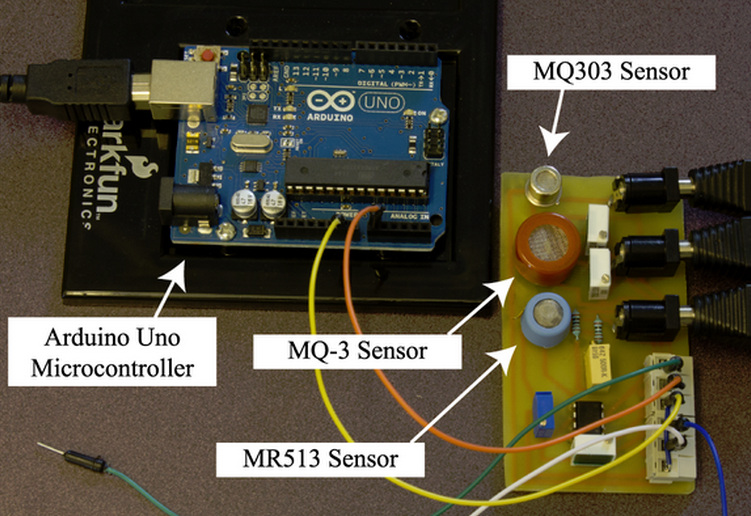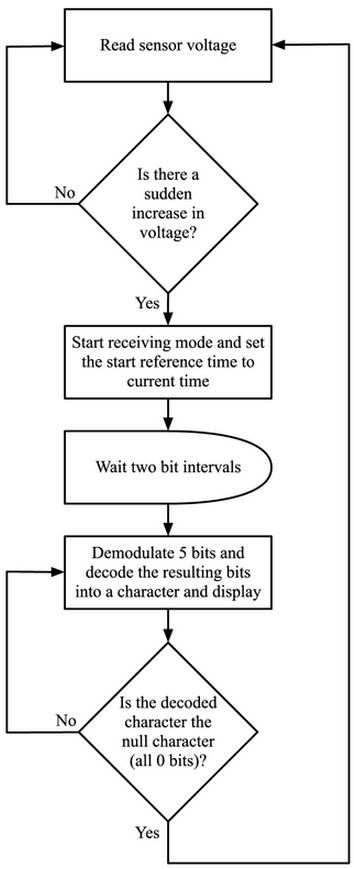World’s first text message via molecular communication sent
May be useful for communication underground, underwater, or inside the body
December 20, 2013
[+]
Scientists have created a molecular communications system for the
transmission of messages and data in challenging environments where
electromagnetic waves cannot be used — such as tunnels, pipelines,
underwater, within the body, and in biomedical nanorobots.
Molecular
transmitter: letters are entered in the LCD Shield Kit and encoded in
the Arduino Uno board as a binary sequence of five bits (e.g., E =
10000, using the least number of 1′s) and each bit is sent to the spray
device to spray (1) or not spray (0) isopropyl alcohol, propagated by a
fan (credit: N. Farsad et al./PLOS ONE)
Molecular signaling is a common feature of the plant and animal kingdom — insects for example use pheromones for long-range signalling — but to date, continuous data have not been transmitted using this method.
Researchers at the University of Warwick in the UK and the York University in Canada have developed the capability to transform any generic message into binary signals. These are in turn “programmed” into evaporated alcohol molecules to demonstrate the potential of molecular communications.
Their results are published in the open-access journal PLOS ONE.
World’s first text message via molecular communication
[+]
The first demonstration signal, performed in Canada, was “O Canada,”
from the Canadian national anthem. It was sent several meters across
open space before it was decoded by a receiver. The hardware is made
from off-the-shelf electronics and costs around $100.
Molecular
receiver: one of three sensors (for various types of tests) demodulates
the incoming signal by assigning the bit 1 to increasing concentration
and 0 to decreasing. The binary data is converted back to letters in the
Arduino board and sent via serial port to a computer for display.
(Credit: N. Farsad et al./PLOS ONE)
“We believe we have sent the world’s first text message to be transmitted entirely with molecular communication, controlling concentration levels of the alcohol molecules, to encode the alphabets with single spray representing bit 1 and no spray representing the bit 0,” said York doctoral candidate Nariman Farsad, who led the experiment.
“Imagine sending a detailed message using perfume — it sounds like something from a spy thriller novel, but in reality it is an incredibly simple way to communicate,” said Dr. Weisi Guo from the School of Engineering at the University of Warwick.
[+]
“Of course, signaling or cues are something we see all the time in
the natural world — bees for example use chemicals in pheromones to
signal to others when there is a threat to the hive, and people have
achieved short-range signaling using chemicals.
Molecular receiver flowchart (credit: N. Farsad et al./PLOS ONE)
“But we have gone to the next level and successfully communicated continuous and generic messages over several meters.
“Potential targeted applications include wireless monitoring of sewage works and oil rigs. This could prevent future disasters such as the bus-sized fatberg found blocking the London sewage networks in 2013, and the Deepwater Horizon oil spill in 2010.
“They can also be used to communicate on the nanoscale, for example, in medicine, where recent advances mean it’s possible to embed sensors into the organs of the body or create miniature robots to carry out a specific task, such as targeting drugs to cancer cells.
“On these tiny scales and in special structural environments, there are constraints with electromagnetic signals such as the ratio of antenna size to the wavelength of the signal, which chemical communication does not have. Molecular communication signals are also biocompatible and require very little energy to generate and propagate.”
The team will now set up a company that aims to bring a range of academic and industrial products to the market within 6 months to 1 year, Guo told KurzweilAI.
Abstract of PLOS ONE paper
In this work, we describe the first modular, and programmable platform capable of transmitting a text message using chemical signalling – a method also known as molecular communication. This form of communication is attractive for applications where conventional wireless systems perform poorly, from nanotechnology to urban health monitoring. Using examples, we demonstrate the use of our platform as a testbed for molecular communication, and illustrate the features of these communication systems using experiments. By providing a simple and inexpensive means of performing experiments, our system fills an important gap in the molecular communication literature, where much current work is done in simulation with simplified system models. A key finding in this paper is that these systems are often nonlinear in practice, whereas current simulations and analysis often assume that the system is linear. However, as we show in this work, despite the nonlinearity, reliable communication is still possible. Furthermore, this work motivates future studies on more realistic modelling, analysis, and design of theoretical models and algorithms for these systems.
(¯`*• Global Source and/or more resources at http://goo.gl/zvSV7 │ www.Future-Observatory.blogspot.com and on LinkeIn Group's "Becoming Aware of the Futures" at http://goo.gl/8qKBbK │ @SciCzar │ Point of Contact: www.linkedin.com/in/AndresAgostini
 Washington
Washington